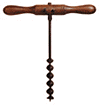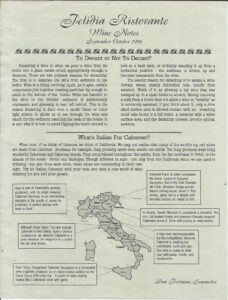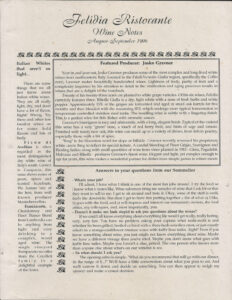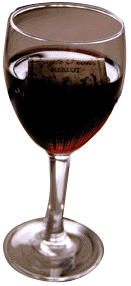Q San Francisco
April/May 1996
Pages 44-45
Summer Parties
You have an incredible terrace with the best view in the city. It is modest, however, limited to accommodating no more than forty of your closest, dearest friends. Your budget will not allow for any more than a few kilos of caviar and certainly no more than three cases of Dom Perignon – in magnums.
From my fire escape (comfortably seating two) overlooking the local chapter of the Hell’s Angels parking strip, I will, however, try to advise. My delightfully spacious studio apartment makes a swell place for a gathering of eight close friends, or six casual acquaintances. For my last summer party I invited fifty. Many of them brought dates. It was a raging success.
Summer parties en appartement are based on the well-known economic principle “KYSSS” — Keep Your Soiree Simple, Sweetheart! You need a theme. It doesn’t have to be something exotic like requiring everyone wear red or tropical fruit hats, or serving Hawaiian barbecue from a pit dug in your very own windowbox.
At my last party I chose Italian wine and cheese. I sent out incredibly witty invitations with Dante’s inscription from over the gates of Hell (in both the original Latin and an English translation) and a sketch of the leaning tower. I served Italian wine, beer, cheese, olives and those great hot cherry peppers stuffed with parmesan and prosciutto. There were still hangers-on when the sun broke the horizon.
Select your food and wine in keeping with your theme. There are, in my view, a few “musts.” A crudite plate: raw vegetables, fruit, and some kind of dip. Cheese: even though I have to pop lactase pills to eat the stuff, I love it. Bready, crackery, chippy kinds of things with dip. And, of course, something sweet like cookies or brownies.
You’ll have to figure out decorations, party favors, and your own ensemble yourself. I’ve been wearing black since the late 1970s. Not because I was anticipating its trendiness in the 1990s, but because I don’t have to worry about coordinating anything with anything else. I saw a picture of someone wearing a striped tie with an identically striped shirt the other day. My boyfriend, a designer, said it was okay. I don’t know, it looked awfully complicated to me.
Enough rambling. Let’s get onto some food and wine favorites for summer partying.
 You have an incredible terrace with the best view in the city. It is modest, however, limited to accommodating no more than forty of your closest, dearest friends. Your budget will not allow for any more than a few kilos of caviar and certainly no more than three cases of Dom Perignon – in magnums.
You have an incredible terrace with the best view in the city. It is modest, however, limited to accommodating no more than forty of your closest, dearest friends. Your budget will not allow for any more than a few kilos of caviar and certainly no more than three cases of Dom Perignon – in magnums.
Aioli Dip
Been there, done that, bought a t-shirt. It’s a classic — no one ever turns it down. A favorite for dipping those veggies.
8 cloves of garlic
1/4 cup fresh Italian parsley leaves
4 egg yolks
1/2 teaspoon salt
1/8 teaspoon white pepper
Juice of 2 lemons
2 cups extra virgin olive oil
In a food processor whip yolks, salt and lemon juice until pale and thick.
Slowly drizzle oil in through the top.
Don’t pour too quickly or it will separate.
When all the oil is in, you should have a thick sauce – hey, you’ve just made your first homemade mayonnaise!
Continue processing and drop in the garlic and parsley.
Blend thoroughly and then refrigerate for at least 30 minutes to combine flavors.
Makes about 2-1/2 cups.
Smoky Yellow Salsa Dip
This one is a favorite at our parties – it’s just different enough to stop those chip-dippers in their tracks.
3 large yellow tomatoes
1/2 cup finely diced fresh pineapple
1 or 2 yellow habanero peppers
1 yellow bell pepper
1 large Spanish onion
Juice of 2 limes
1/2 cup extra virgin olive oil
1/4 cup chopped fresh mint leaves
1/4 teaspoon liquid smoke
1/2 teaspoon salt
1/2 teaspoon ground pink peppercorns
Roast bell and hot peppers over an open flame (hopefully you don’t have an electric stove) and rotate until skin blisters.
Cool and peel.
Meanwhile, peel and seed tomatoes.
Finely dice tomatoes, pineapple, peppers and onion.
Add lime juice, olive oil, mint leaves and liquid smoke
(okay, it’s cheating, but are you going to buy a food smoker just to make salsa?).
Season with salt and pepper (if you can’t find pink peppercorns, use black or white but only 1/4 teaspoon).
Makes about 3 cups.
Chocolate-Lemon Squares
Since we’ve got this sort of yellow thing going, I thought I’d go with a favorite that bolsters the theme.
Crust:
1 stick of butter
1/4 cup sugar
1-1/4 cups flour
1 egg
1 teaspoon powdered cocoa
Chocolate Filling:
4 ounces bittersweet chocolate, chopped
1/2 cup half-and-half or cream
1 egg
pinch of salt
Lemon Filling:
1/4 cup flour
1/2 teaspoon baking powder
1/8 teaspoon salt
2 eggs
1 cup sugar
Juice and grated zest of 2 lemons
For crust, cream butter and sugar together (food processor is fine for this), add flour, egg and cocoa and process or mix until blended.
Grease and flour 9-inch square baking pan.
Press crust into pan and bake at 375¡F for 10-15 minutes until firm and lightly golden.
For chocolate filling, bring half-and-half to boil and pour over chopped chocolate. Let sit for five minutes.
Whisk together thoroughly. Beat egg lightly with salt and quickly mix into chocolate cream. It will immediately begin to thicken.
Pour over crust.
For lemon filling, beat two eggs with sugar and lemon juice.
Sift flour, baking powder and salt together.
Stir in egg mixture and add lemon zest.
Pour carefully and slowly over chocolate layer.
Layers will swirl a little bit together, but won’t completely mix up.
Reduce heat in oven to 325°F and bake for 25-30 minutes until firm and lightly golden on top.
Cool, cut into squares (6×6 gives 36 good-sized squares) and serve.
Summer Wine Picks
 Summer is a time for crisp, light wines with lots of zip and character. Well-chilled Sauvignon blancs are my favorites for hot day drinking. Choices should be “as young as possible,” with wines from the southern hemisphere being 1995 vintage and from the northern, generally the 1994s. Here are my round-the-world picks for this year
Summer is a time for crisp, light wines with lots of zip and character. Well-chilled Sauvignon blancs are my favorites for hot day drinking. Choices should be “as young as possible,” with wines from the southern hemisphere being 1995 vintage and from the northern, generally the 1994s. Here are my round-the-world picks for this year
Starting in the down-under part of the globe, Cloudy Bay in New Zealand makes a ripe, rich Sauvignon that is best described as “raspberries climbing out of the glass.” Nearby Stoneleigh is similar but a little leaner with a more “green” character. A good part of the way around the world, from South Africa, the unpronounceable, but basically unbeatable, Buitenverwachting Sauvignon blanc is minerally, grassy, and perfect for summer drinking. Running a close second is the entry from Mulderbosch. Also from the deep south, Chile delivers up the tart and tasty Santa Rita Reserva. The runner-up, Miguel Torres, a top Spanish producer who was one of the earliest investors in the rejuvenation of the Chilean wine industry.
Moving north and way east, the French entries that grabbed my attention most recently were the Domaine Fernand Girard Sancerre “La Garenne” and the Domaine de la Charmoise Touraine “Cuvee M.” Unfortunately, my top choice for California Sauvignon blanc is not available on the market — the Araujo Estate “Eisele Vineyard” may just be one of the best to come out of the state. But coming in close behind, latch onto the latest offerings from Sanford if you love that herbal, lean style, or, if you prefer a richer, fuller style, try the new release of the Peter Michael “L’Apres Midi.”
Q San Francisco magazine premiered in late 1995 as a ultra-slick, ultra-hip gay lifestyle magazine targeted primarily for the San Francisco community. It was launched by my friends Don Tuthill and Robert Adams, respectively the publisher and editor-in-chief, who had owned and run Genre magazine for several years prior. They asked me to come along as the food and wine geek, umm, editor, for this venture as well. In order to devote their time to Passport magazine, their newest venture, they ceased publication of QSF in early 2003.





 Felidia Ristorante
Felidia Ristorante


